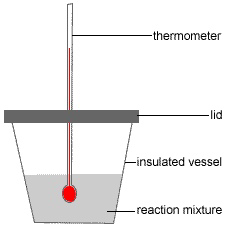AS-Level Chemistry Chapter 6 Chemical Energetics Enthalpy Changes
To view other notes related to AS-Level Chemistry. Please Click Here.
Enthalpy Changes
Exothermic and endothermic reactions
1) Most chemical reactions are accompanied by energy changes. Some absorbs energy while some releases it.
2) An exothermic reaction is a reaction that releases energy to the surroundings. Therefore the product contain less energy with respect to the reactants. The energy is released as heat energy, so the surroundings warm up.
3) An endothermic reaction is a reaction that absorbs energy from the surroundings. Therefore the products contain more energy with respect to the reactants. The energy is absorbed as heat energy, so the surroundings cool down.
4) An energy level diagram shows the relative energies of the products and reactants. The higher its energy, the higher its position.
5) i. Examples of exothermic reactions are neutralization, combustion, dissolving anhydrous salts and the reaction between acids and metal carbonates.
ii. Examples of endothermic reactions are atomization, photosynthesis,dissolving crystalline salts and thermal decomposition.
Enthalpy changes
1) Enthalpy, H is an indication of the total energy of a substance and it cannot be measured directly. However, enthalpy change, ΔH is measurable.
2) Enthalpy change of a reaction, ΔH is the heat change(heat is absorbed or evolved) when a chemical reaction takes place.
3) i. In exothermic reactions, the enthalpy change is always negative.(ΔH < 0)
ii. In endothermic reactions, the enthalpy change is always positive.(ΔH > 0)
Energetic stability of a system
1) Exothermic reactions are more energetically favorable than endothermic ones because a system with lower energy content is more stable.
2) Thus, the more negative the ΔH value, the more stable the system is.
3) For example, oxygen,O2 is energetically more stable than ozone, O3. Their relative positions on the energy level diagram are as follow:
4) But ozone does not convert to oxygen immediately in atmosphere, this is because ozone is kinetically stable although it is energetically unstable with respect to the products. The activation energy is not sufficient for the reaction to take place.
Measuring enthalpy changes
1) Enthalpy changes can be measured experimentally by measuring the temperature change as a reaction proceeds. Two common examples are measuring the enthalpy change of neutralization and combustion.
2) The formulae:
Heat energy absorbed or released = mcΔT
where m = mass of substance(or solution)/g
c = specific heat capacity of solution/J g⁻¹ °C⁻¹ (c is normally assumed to be 4.18 J g⁻¹ °C⁻¹)
ΔT = change in temperature/°C
ΔH = heat energy absorbed or released / no. of moles of the limiting reagent
Unit = kJ mol⁻¹
3) Assumptions made in this calculation:
- The solution has the same specific heat capacity as water(4.18 J g⁻¹ °C⁻¹).
4) An example - to calculate the enthalpy change of the reaction between sodium hydroxide, NaOH(aq) and hydrochloric acid, HCl(aq).
NaOH(aq) + HCl(aq) → NaCl(aq) + H2O(l)
i. Pour 25 cm³ of NaOH into 25 cm³ of HCl in a polystyrene cup(polystyrene cup is used because it is a good heat insulator). Both solutions have concentrations of 1.0 mol dm⁻³.
ii. Measure the initial and maximum temperature reached.
iii. For example, the mean initial temperature of both solutions is 18.1 °C and the maximum temperature reached is 24.8 °C. Then, ΔT = 6.7 °C.
iv. Mass of both solutions is (25+25) x 1 = 50 g since density = mass/volume.
v. Therefore heat released = 50 x 4.18 x 6.7 = 1400 J = 1.4 kJ
vi. Number of moles of water = 0.025 mol
vii. Therefore ΔH = -(1.4/0.025) = -56 kJ mol⁻¹
5) Another example - to calculate the enthalpy change of the reaction of combustion of ethanol, C2H5OH.
C2H5OH(l) + 3O2(g) → 2CO2(g) + 3H2O(g)
i. In this experiment, a spirit burner is used to combust the flammable liquid ethanol. The heat evolved is used to heat up the water, the maximum temperature reached is then measured.
Initial temperature of water = 19.5 °C
Maximum temperature of water = 23.7 °C
Initial mass of ethanol = 41.36 g
Final mass of ethanol = 41.18 g
iii. Therefore, ΔT = 4.2 °C and m = 250 g.
iv. Heat released = 250 x 4.18 x 4.2 = 4389 J = 4.389 kJ
v. Number of moles of ethanol burned = 0.18/46 = 0.0039 mol
vi. Therefore ΔH = -(4.389/0.0039) = -1100 kJ mol⁻¹ (2 s.f)




